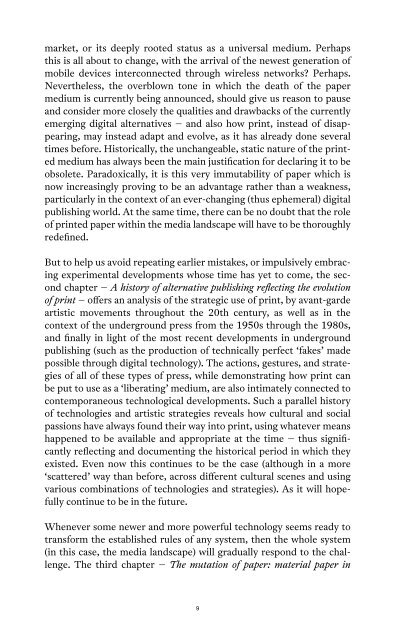Post- Digital Print - Monoskop
Post- Digital Print - Monoskop
Post- Digital Print - Monoskop
Create successful ePaper yourself
Turn your PDF publications into a flip-book with our unique Google optimized e-Paper software.
market, or its deeply rooted status as a universal medium. Perhaps<br />
this is all about to change, with the arrival of the newest generation of<br />
mobile devices interconnected through wireless networks? Perhaps.<br />
Nevertheless, the overblown tone in which the death of the paper<br />
medium is currently being announced, should give us reason to pause<br />
and consider more closely the qualities and drawbacks of the currently<br />
emerging digital alternatives – and also how print, instead of disappearing,<br />
may instead adapt and evolve, as it has already done several<br />
times before. Historically, the unchangeable, static nature of the printed<br />
medium has always been the main justification for declaring it to be<br />
obsolete. Paradoxically, it is this very immutability of paper which is<br />
now increasingly proving to be an advantage rather than a weakness,<br />
particularly in the context of an ever-changing (thus ephemeral) digital<br />
publishing world. At the same time, there can be no doubt that the role<br />
of printed paper within the media landscape will have to be thoroughly<br />
redefined.<br />
But to help us avoid repeating earlier mistakes, or impulsively embracing<br />
experimental developments whose time has yet to come, the second<br />
chapter – A history of alternative publishing reflecting the evolution<br />
of print – offers an analysis of the strategic use of print, by avant-garde<br />
artistic movements throughout the 20th century, as well as in the<br />
context of the underground press from the 1950s through the 1980s,<br />
and finally in light of the most recent developments in underground<br />
publishing (such as the production of technically perfect ‘fakes’ made<br />
possible through digital technology). The actions, gestures, and strategies<br />
of all of these types of press, while demonstrating how print can<br />
be put to use as a ‘liberating’ medium, are also intimately connected to<br />
contemporaneous technological developments. Such a parallel history<br />
of technologies and artistic strategies reveals how cultural and social<br />
passions have always found their way into print, using whatever means<br />
happened to be available and appropriate at the time – thus significantly<br />
reflecting and documenting the historical period in which they<br />
existed. Even now this continues to be the case (although in a more<br />
‘scattered’ way than before, across different cultural scenes and using<br />
various combinations of technologies and strategies). As it will hopefully<br />
continue to be in the future.<br />
Whenever some newer and more powerful technology seems ready to<br />
transform the established rules of any system, then the whole system<br />
(in this case, the media landscape) will gradually respond to the challenge.<br />
The third chapter – The mutation of paper: material paper in<br />
9

















